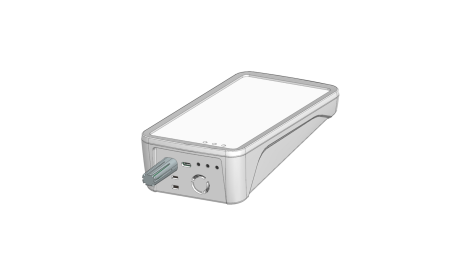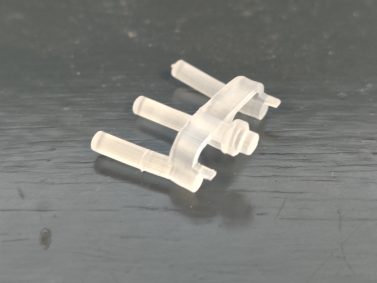Specifications and choice of materials as a basis
Fluctus took the lead in the design process based on the specifications they received from the developer KITT Engineering. During the design process, careful consideration was given to where the sensors and components could best be placed. This meant that careful consideration was given to the influence of environmental factors – temperature, humidity and UV radiation – on the materials chosen for the housing. The suitability of these materials is essential to ensure that the Environmental Monitor has a long life and continues to perform well, regardless of the conditions in which it is placed.

By: Melvin Brink
Environmental Monitor Housing Dissected
Do you want to know if there are harmful substances in the air of your living room, or are you worried about odor or noise pollution? Then the trade fair gadget of the World of Industry, Technology & Science 2024 will certainly appeal to you. The Environmental Monitor monitors the temperature, humidity, noise and particulate matter in the environment.
The housing of the Environmental Monitor is the result of a collaboration between Fluctus, Comdes Components and Phoenix Mecano. Together they have created a practical and user-friendly housing that is perfectly suited for measuring environmental factors in the open air. How this housing is designed you can read in this article.

Standard housing as a starting point
In order to save costs and time, Phoenix Mecano suggested working with a standard enclosure. Although some adjustments were required, Bopla's BoPad (BOP 900 PH-9016) proved to be an excellent choice. This enclosure not only meets the required technical specifications, but also has a well-thought-out design that offers functional advantages, such as good drainage.
The BoPad is made of ABS. This material is strong, light and resistant to environmental influences. The housing meets the IP40 standard as standard and thus makes it possible to protect the Environmental Monitor against dust and water. The BoPad is designed as a desk, so that the slanted top ensures that rainwater does not remain on the housing but flows off of it automatically.

Editing and custom made parts
The BoPad provides a solid base for the Environmental Monitor. However, some adjustments are needed to make the housing fully suitable for this application. While Phoenix Mecano started working on the adjustments, Comdes Componenten and Fluctus joined forces to design custom parts. One of the main challenges was to place the sensors outside the housing. This allows the sensors to work unobstructed, so that they can perform their measurements as accurately as possible.
After quite some brainstorming, a kind of “hat” was created that fits exactly over the sensors. This hat is clamped to the inside of the housing. Thanks to notches in the hat, the sensors can take measurements without the housing obstructing the measurement.

Positioning the PCB
Comdes Componenten and Fluctus then worked together to optimize the positioning and mounting of the PCB in the housing. Fluctus designed a bracket that is screwed into the Bopla housing. This bracket places the PCB at a specific angle, so that the sensors are perfectly aligned with the housing. Comdes Componenten then produced the bracket together with the corresponding hat.
However, there was still a challenge: the LED indicators had to be clearly visible on the top of the housing. This problem was solved by developing lightguides (see image), which guide the light from the LEDs to the outside of the housing. Fluctus designed and 3D printed the lightguides.
Integration of the solar panel
The final step in designing the housing is integrating the solar panel into the lid of the Environmental Monitor. Schurter Electronics and Elincom Electronics worked together to sink the solar panel a few millimeters into the Bopla housing. However, this also entailed a risk: water can get in. To prevent this, Schurter Electronics designed a special front foil that ensures that the cover remains (as much as possible) waterproof.
When choosing the material for this foil, the transmission of sunlight was taken into account. The foil must ensure that the solar panel can perform optimally without the energy yield suffering.
Practical solution
The development of the housing for the Environmental Monitor shows how powerful collaboration can be. The parties involved have combined their expertise, which has led to a practical and impressive end result. At the end of this month, visitors to the trade fair will have the opportunity to experience for themselves what the housing looks like and what it has to offer. All in all, we are proud of what we have achieved together and we can't wait to share it with you!
Sign In and collect your own Environmental Monitor.